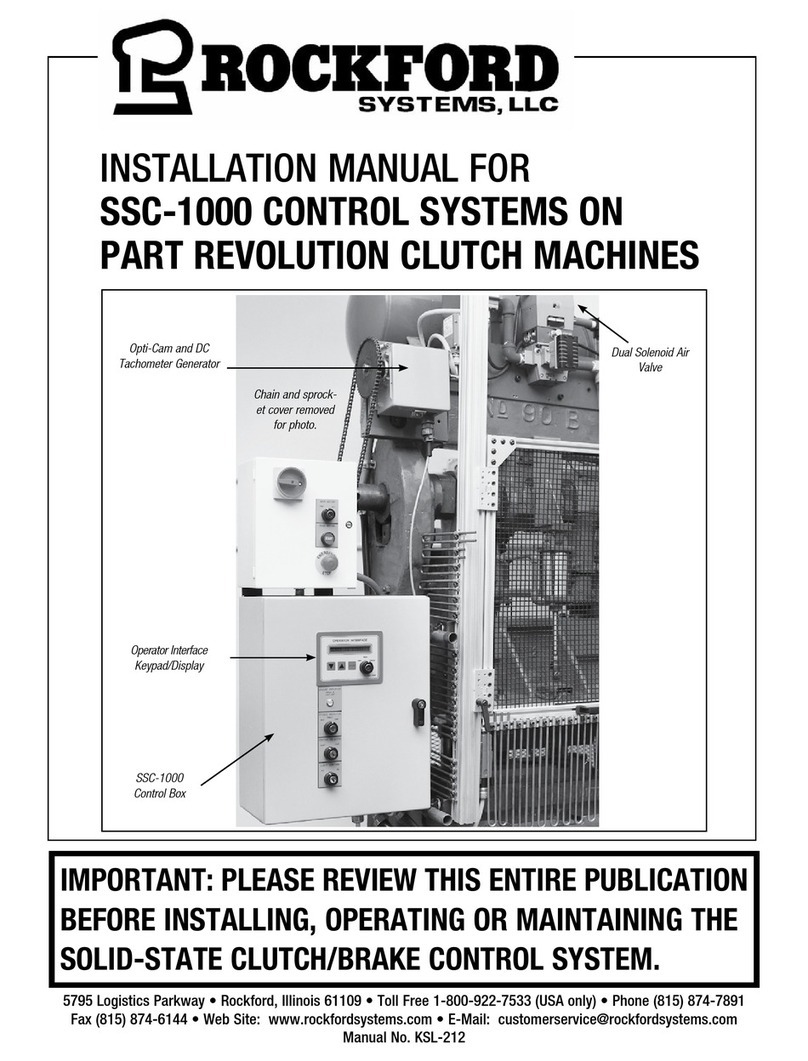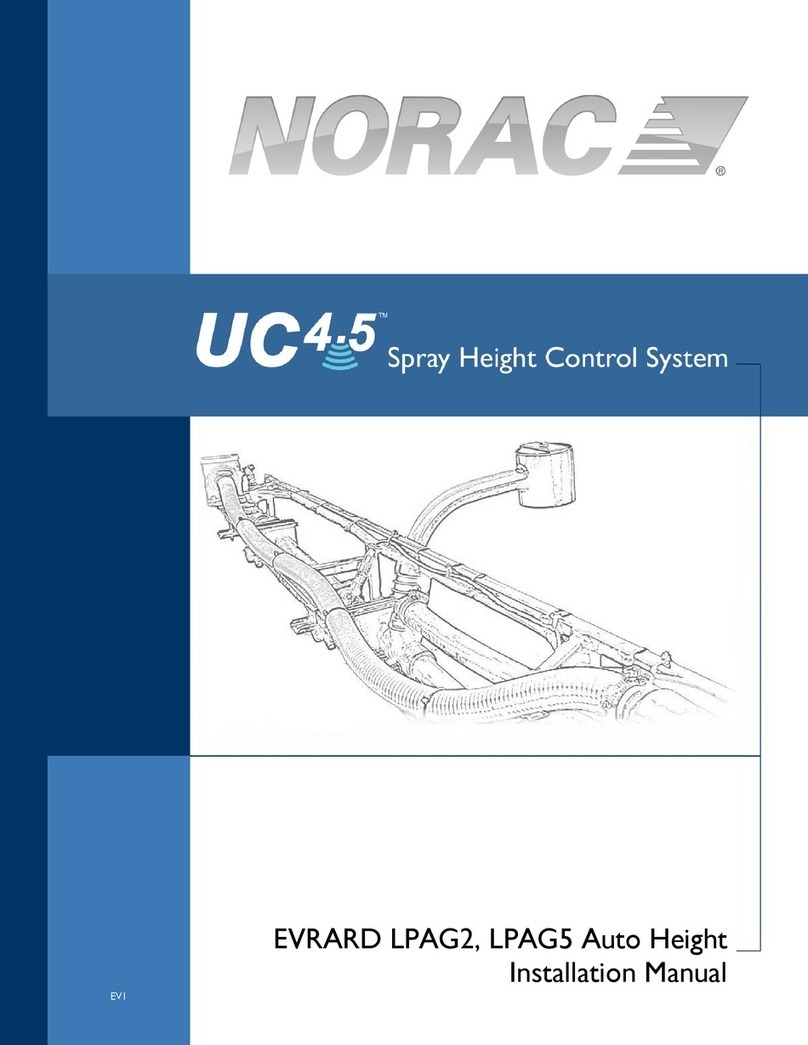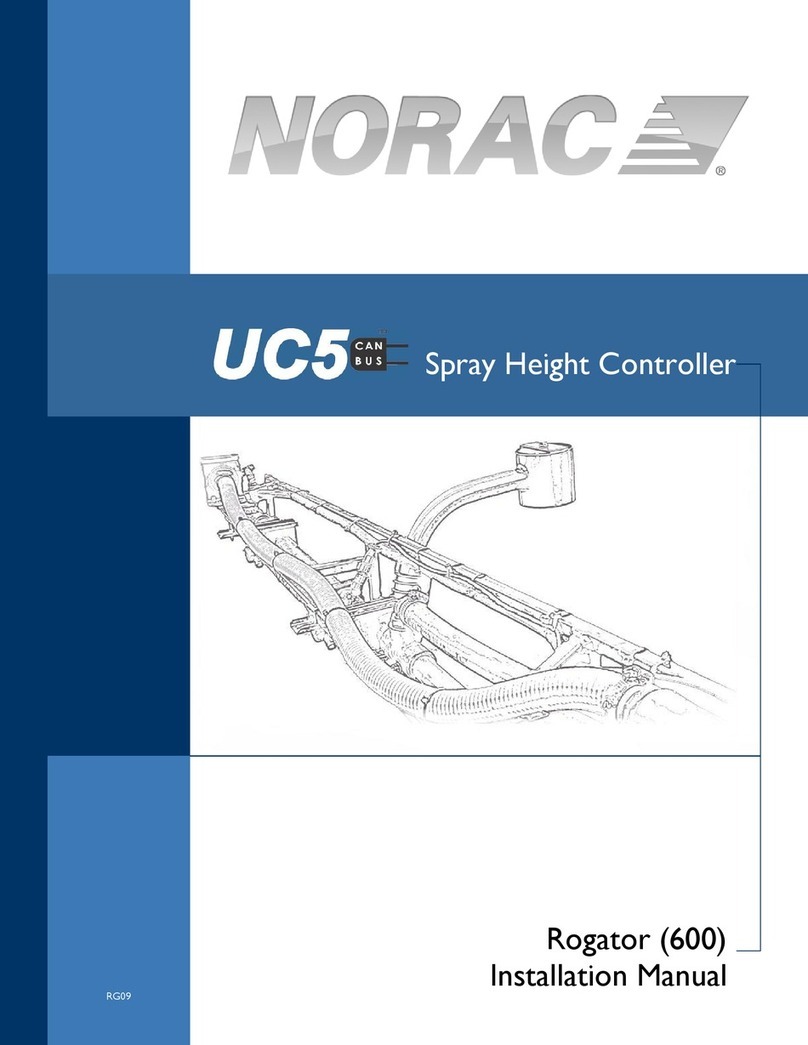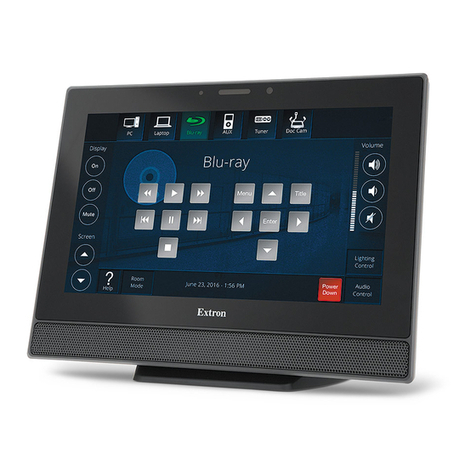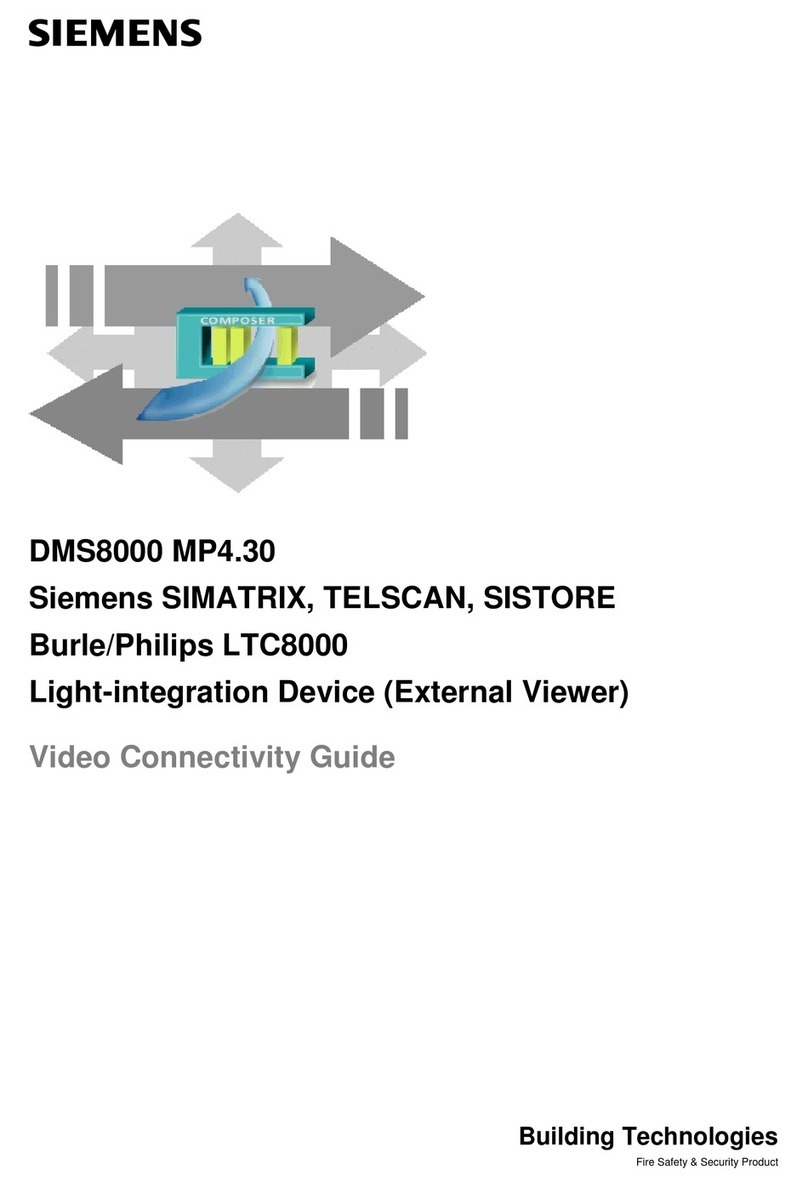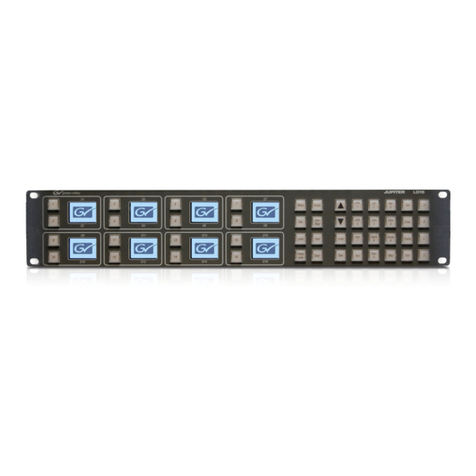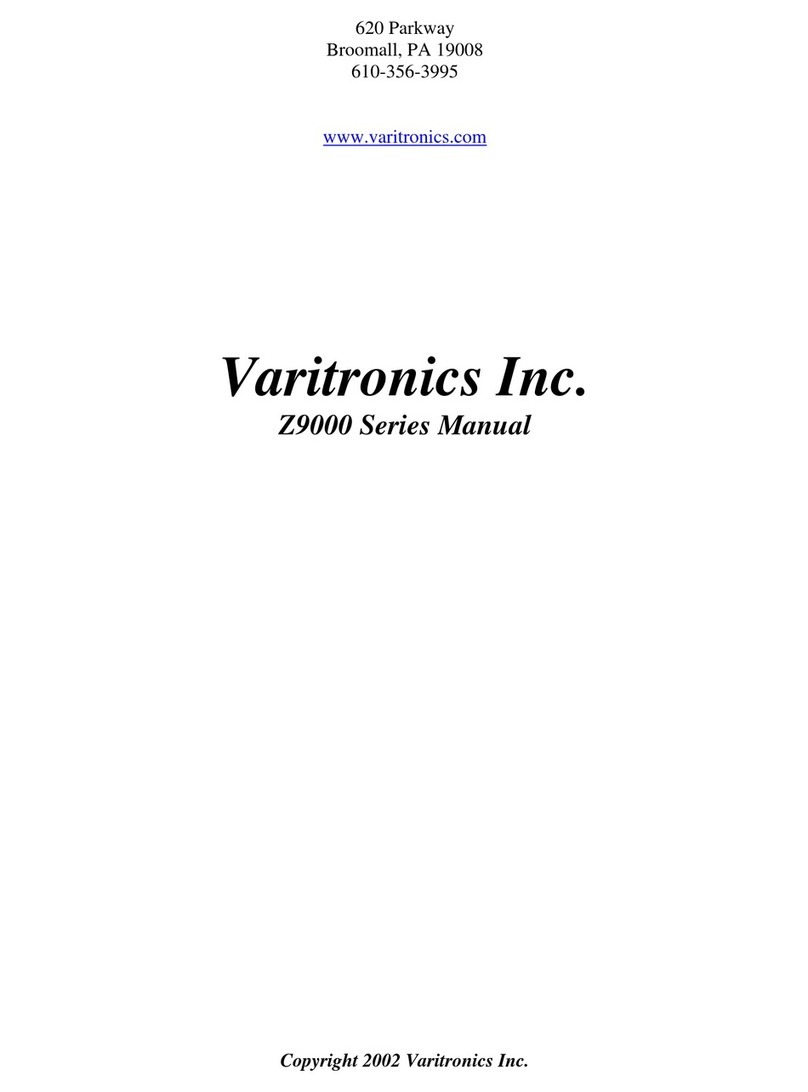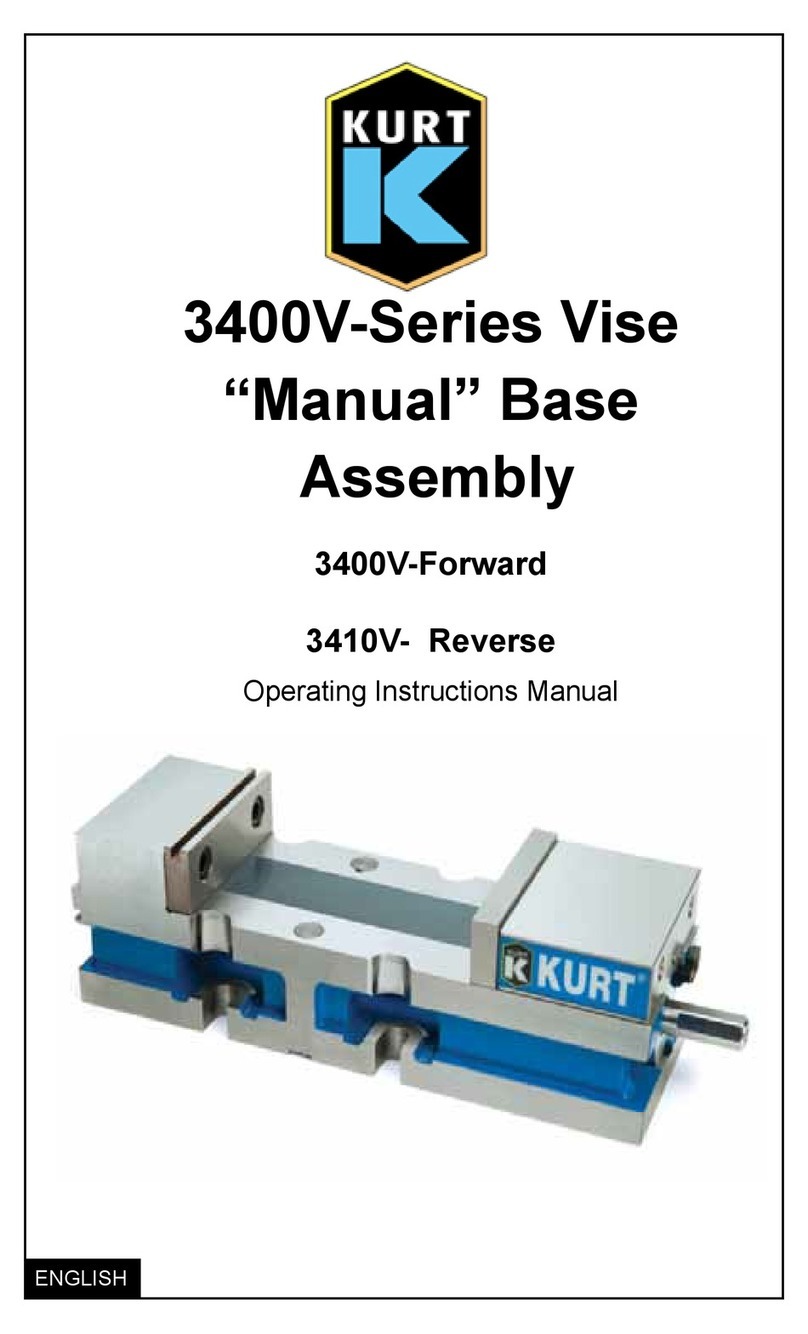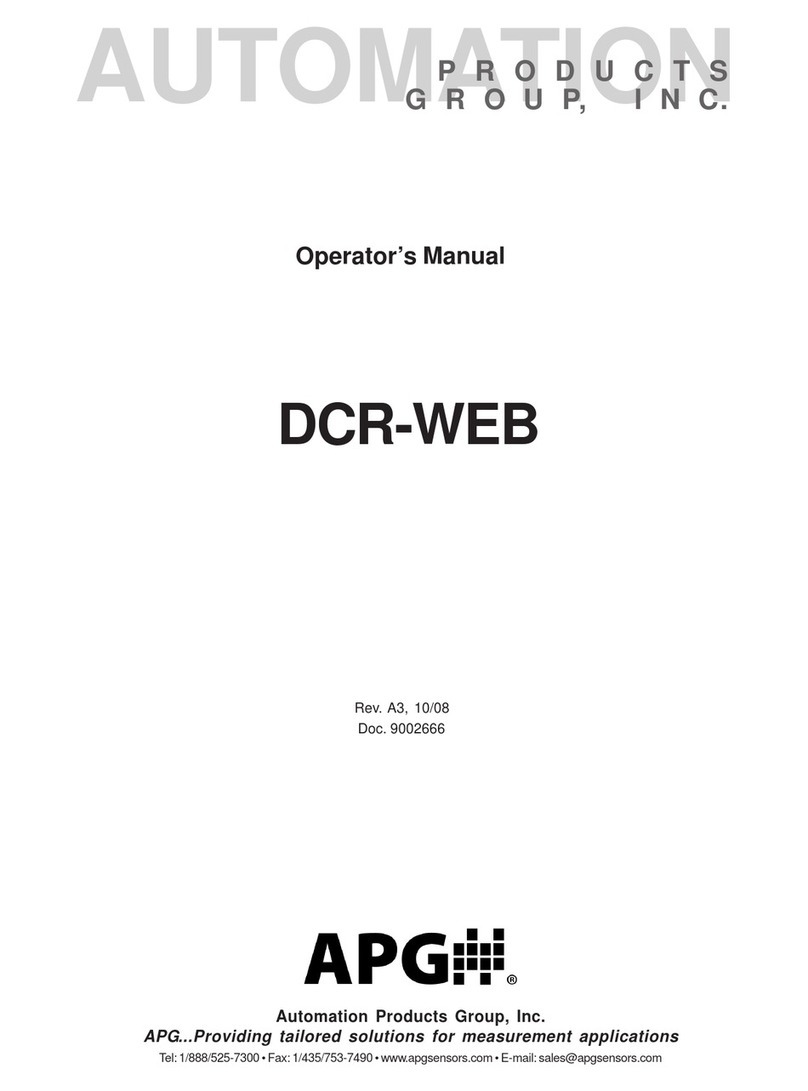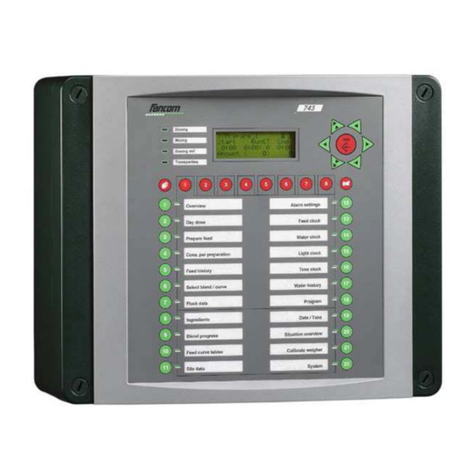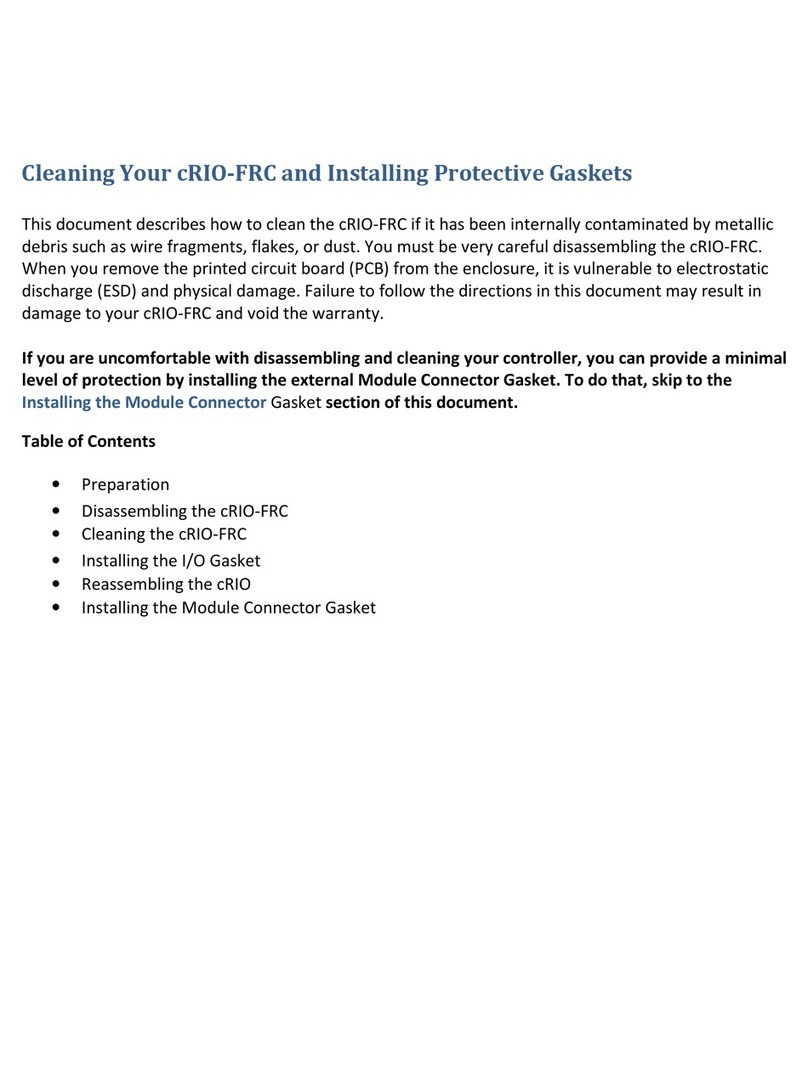Rockford Systems SSC-1500 User manual

IMPORTANT: PLEASE REVIEW THIS ENTIRE PUBLICATION
BEFORE INSTALLING, OPERATING OR MAINTAINING THE SOLID-
STATE CLUTCH/BRAKE CONTROL SYSTEM.
4620 Hydraulic Road • Rockford, Illinois 61109 • Toll Free 1-800-922-7533 (USA only) • Phone (815) 874-7891
Manual No. KSL-276
INSTALLATION MANUAL FOR
SSC-1500 CONTROL SYSTEMS ON
PART REVOLUTION CLUTCH MACHINES
Plain-Door Custom
Control Box
Resolver/Pulser
Assembly
Remote
Operator
Station
Light
Curtains
Palm Button
Assembly

Rockford Systems, LLC
2Call: 1-800-922-7533
SSC-1500 Part Revolution Solid-State Control
TABLE OF CONTENTS
(Continued on next page.)
SECTION 1—IN GENERAL ...................................................................................................................................................................3 - 5
SECTION 2—INTRODUCTION ............................................................................................................................................................6 - 12
SECTION 3—INSTALLATION OF COMPONENTS..............................................................................................................................13 - 36
Introduction........................................................................................................................................................................................ 13
Literature Folder..........................................................................................................................................................................13 - 15
Control Box .................................................................................................................................................................................15 - 21
Resolver/Pulser Assembly................................................................................................................................................................... 22
Sprocket Assembly............................................................................................................................................................................. 23
Roller Chain ....................................................................................................................................................................................... 23
Monitored Dual Solenoid Air Valve ...................................................................................................................................................... 24
Filter-Regulator-Lubricator Assembly................................................................................................................................................... 24
Air Pressure Switch ............................................................................................................................................................................ 25
Check Valves for Counterbalance Systems........................................................................................................................................... 25
Palm Button Assembly.................................................................................................................................................................25 - 31
Foot Switch.................................................................................................................................................................................31 - 32
Multiple Operator Station .................................................................................................................................................................... 32
Bar/Run Station.................................................................................................................................................................................. 32
Other Components ......................................................................................................................................................................33 - 36
Other Installation Considerations ..................................................................................................................................................36 - 38
SECTION 4—PROGRAMMING .........................................................................................................................................................39 - 64
User Inputs .................................................................................................................................................................................42 - 45
Brake Monitor .............................................................................................................................................................................46 - 48
Counters............................................................................................................................................................................................ 49
System Setup..............................................................................................................................................................................50 - 53
Angle Settings.............................................................................................................................................................................54 - 55
Timed Settings............................................................................................................................................................................56 - 57
Optional Modes...........................................................................................................................................................................58 - 60
Variable Speed Top-Stop Settings ................................................................................................................................................61 - 62
PLS Outputs....................................................................................................................................................................................... 63
Auxiliary Output...........................................................................................................................................................................64 - 65
Quick Reference Table—Factory Settings and Valid Ranges................................................................................................................. 66
SECTION 5—FATAL FAULT MESSAGES AND GENERAL FAULT MESSAGES ...................................................................................67 - 69
SECTION 6—OPERATING CONSIDERATIONS...................................................................................................................................70 - 71
SECTION 7—MAINTENANCE AND INSPECTION...............................................................................................................................72 - 73
SECTION 8—REPLACEMENT PROCEDURES ....................................................................................................................................74 - 76
SECTION 9—METHODS OF SAFEGUARDING....................................................................................................................................77 - 78
SECTION 10—RETURN MATERIALS AUTHORIZATION REQUEST FORM................................................................................................. 79
SECTION 11—ORDER FORM FOR SIGNS AND LITERATURE................................................................................................................... 80
© 2017 Rockford Systems, LLC. All rights reserved. Not to be reproduced in whole or in part without written permission. Litho in U.S.A.

Rockford Systems, LLC.
Call: 1-800-922-7533 3
SSC-1500 Part Revolution Solid-State Control
SECTION 1—IN GENERAL
Efficient and safe machine operation depends on the development, implementation and enforcement of a safety program. This program requires,
among other things, the proper selection of point-of-operation guards and safety devices for each particular job or operation and a thorough safety
training program for all machine personnel. This program should include instruction on the proper operation of the machine, instruction on the
point-of-operation guards and safety devices on the machine, and a regularly scheduled inspection and maintenance program.
Rules and procedures covering each aspect of your safety program should be developed and published both in an operator’s safety manual, as
well as in prominent places throughout the plant and on each machine. Some rules or instructions which must be conveyed to your personnel
and incorporated in to your program include:
Danger is used to indicate the presence of a hazard which WILL cause SEVERE
personal injury if the warning is ignored.
THIS SAFETY ALERT SYMBOL IDENTIFIES IMPORTANT SAFETY MESSAGES IN THIS MANUAL.
WHEN YOU SEE THIS SYMBOL , BE ALERT TO THE POSSIBILITY OF PERSONAL INJURY, AND
CAREFULLY READ THE MESSAGE THAT FOLLOWS.
A company’s safety program must involve everyone in the company, from top management to operators, since only as a group can any
operational problems be identified and resolved. It is everyone’s responsibility to implement and communicate the information and material
contained in catalogs and instruction manuals to all persons involved in machine operation. If a language barrier or insufficient education would
prevent a person from reading and understanding various literature available, it should be translated, read or interpreted to the person, with
assurance that it is understood.
DANGER
“ ”
“ ”
Safety Precautions
FOR MAINTENANCE AND INSPECTION ALWAYS REFER TO THE OEM’s (ORIGINAL EQUIPMENT
MANUFACTURER’S) MAINTENANCE MANUAL OR OWNER’S MANUAL. If you do not have an owner’s
manual, please contact the original equipment manufacturer.
(Continued on next page.)
Never place your hands or any part of your body in this machine.
Never operate this machine without proper eye, face and body protection.
Never operate this machine unless you are fully trained, instructed, and have read the instruction manual.
Never operate this machine if it is not working properly—stop operating and advise your supervisor immediately.
Never use a foot switch to operate this machine unless a point-of-operation guard or device is provided and
properly maintained.
Never operate this machine unless two-hand trip, two-hand control or presence sensing device is installed at
the proper safety distance. Consult your supervisor should you have any questions regarding the proper safety
distance.
Never tamper with, rewire or bypass any control or component on this machine.
DANGER
DANGER

Rockford Systems, LLC
4Call: 1-800-922-7533
SSC-1500 Part Revolution Solid-State Control
SECTION 1—IN GENERAL
ANSI SAFETY STANDARDS FOR MACHINES
The most complete safety standards for machine tools are published
in the ANSI (American National Standards Institute) B11 series. The
following is a list of each ANSI B11 Standard available at the printing
of this publication.
B11.1 Mechanical Power Presses
B11.2 Hydraulic Presses
B11.3 Power Press Brakes
B11.4 Shears
B11.5 Iron Workers
B11.6 Lathes
B11.7 Cold Headers and Cold Formers
B11.8 Drilling, Milling and Boring
B11.9 Grinding Machines
B11.10 Sawing Machines
B11.11 Gear Cutting Machines
B11.12 Roll Forming and Roll Bending
B11.13 Automatic Screw/Bar and Chucking
B11.14 Coil Slitting Machines
B11.15 Pipe, Tube and Shape Bending
B11.16 Metal Powder Compacting Presses
B11.17 Horizontal Hydraulic Extrusion Presses
B11.18 Coil Processing Systems
B11.19 Safeguarding Performance Criteria
B11.20 Safety Requirements for Manufacturing Sys-tems/Cells
B11.21 Lasers
B11.22 CNC Turning Machines
B11.23 Machining Centers
B11.24 Transfer Machines
B11/TR1 Ergonomics
B11/TR2 Mist Control
B11/TR3 Risk Assessment
B11/TR4 Control Reliability for Design, Construction, and Validation
of PESs
R15.06 Robotic Safeguarding
These standards can be purchased by contacting:
American National Standards Institute, Inc.
11 West 42nd Street
New York, New York 10036
Phone: (212) 642-4900
Fax: (212) 302-1286
www.ansi.org
OR
Association of Manufacturing Technology (AMT)
7901 Westpark Drive
McLean, Virginia 22102
Phone: (703) 827-5211
Fax: (703) 893-1151
www.mfgtech.org
Safety References
OSHA’S ACT AND FEDERAL REGULATIONS
Since the enclosed equipment can never overcome a mechanical
deficiency, defect or malfunction in the machine itself, OSHA
(Occupational Safety and Health Administration) has established certain
safety regulations that the employers (users) must comply with so that
the machines used in their plants, factories or facilities are thoroughly
inspected and are in first-class operating condition before any of the
enclosed equipment is installed.
1. U.S. Government An Act – Public Law 91 - 596, 91st
Congress, S. 2193, December 29, 1970
Duties:
Sec. 5. (a) Each employer —
(1) shall furnish to each of his employees employment and a place
of employment which are free from recognized hazards that
are causing or are likely to cause death or serious physical
harm to his employees;
(2) shall comply with occupational safety and health standards
promulgated under this Act.
(b) Each employee shall comply with occupatioal safety and
health standards and all rules, regultions, and orders issued
pursuant to this Act which are applicable to his own actions
and conduct.
2. OSHA’s Code of Federal Regulations, Subpart O, that an
employer (user) must comply with include:
Section 1910.211 Definitions
Section 1910.212 (a) General Requirements for all Machines
Section 1910.217 Mechanical Power Presses
Section 1910.219 (b)(1) Mechanical Power-Transmission Apparatus
(Flywheel and Gear Covers)
3. OSHA’s 29 Code of Federal Regulations, Subpart J 1910.147
The Control of Hazardous Energy (Lockout / Tagout)
4. OSHA Publication
“General Industry Safety and Health Regulations Part 1910,” Code
of Federal Regulations, Subpart O
This publication can be obtained by contacting:
Superintendent of Documents
US Government Printing Office
P.O. Box 371954
Pittsburgh, PA 15250-7954
Phone: (202) 512-1800
Fax: (202) 512-2250
www.gpo.gov
(Continued on next page.)

Rockford Systems, LLC.
Call: 1-800-922-7533 5
SSC-1500 Part Revolution Solid-State Control
SECTION 1—IN GENERAL
WARRANTY
Rockford Systems, LLC. warrants that this product will be free from defects in material and workmanship for a period of 12 months from the date of shipment
thereof. ROCKFORD SYSTEMS LLC’S OBLIGATION UNDER THIS WARRANTY IS EXPRESSLY AND EXCLUSIVELY LIMITED to repairing or replacing such products
which are returned to it within the warranty period with shipping charges prepaid and which will be disclosed as defective upon examination by Rockford
Systems, LLC. This warranty will not apply to any product which will have been subject to misuse, negligence, accident, restriction and use not in accordance
with Rockford Systems, LLC.’s instructions or which will have been altered or repaired by persons other than the authorized agent or employees of Rockford
Systems, LLC. Rockford Systems, LLC.’s warranties as to any component part is expressly limited to that of the manufacturer of the component part.
LIMITATION OF LIABILITY
Under no circumstances, including any claim of negligence, strict liability, or otherwise, shall
Rockford Systems, LLC. be liable for any incidental or consequential damages, or any loss or
damage resulting from a defect in the product of Rockford Systems, LLC.
Warranty, Disclaimer and Limitation of Liability
NATIONAL SAFETY COUNCIL SAFETY MANUALS AND DATA
SHEETS
Other good references for safety on machine tools are the National
Safety Council’s Safety Manuals. These manuals are written by
various committees including the Power Press, Forging and Fabricating
Executive Committee. Copies of the following publications are available
from their library:
• Power Press Safety Manual - 4th Edition
• Safeguarding Concept Illustrations - 6th Edition
• Forging Safety Manual
These manuals and can be obtained by contacting:
National Safety Council
1121 Spring Lake Drive
Itasca, IL 60143-3201
1-800-621-7619 ext. 2199
Fax: (630) 285-0797
www.nsc.org
OTHER SAFETY SOURCES
National Institute of Occupational Safety and Health (NIOSH)
4676 Columbia Parkway
Cincinnati, OH 45226
Robotic Industries Association (RIA)
P.O. Box 3724
Ann Arbor, MI 48106
Phone: (313) 994-6088
NEMA (National Electrical Manufacturers Association)
1300 North 17th Street, Suite 1847
Rosslyn, VA 22209
Phone: (703) 841-3200
NFPA 79 Electrical Standard for Industrial Machinery
For additional safety information and assistance in devising,
implementing or revising your safety program, please contact the
machine manufacturer, your state and local safety councils, insurance
carriers, national trade associations and your state’s occupational
safety and health administration.
DISCLAIMER
The foregoing Warranty is made in lieu of all other warranties, expressed or
implied, and of all other liabilities and obligations on the part of Rockford
Systems, LLC., including any liability for negligence, strict liability, or
otherwise, and any implied warranty of merchantability or fitness for a
particular purpose is expressly disclaimed.

Rockford Systems, LLC
6Call: 1-800-922-7533
SSC-1500 Part Revolution Solid-State Control
SECTION 2—INTRODUCTION
General Description of Components in the System
A complete control package for part revolution clutch machines includes the following:
1. Literature folder (see page 13) containing installation manuals, “Operator Safety Precaution” Pamphlet, danger sign(s), electrical control
schematics, and a “Mechanical Power Press Safety” Booklet
2. Control box—standard (custom or special includes motor controls and/or disconnect switch) with danger and warning signs attached
3. Monitored dual solenoid air valve assembly
4. Filter-regulator-lubricator assembly including connector and mounting bracket
5. Air pressure switch (two required if machine has air counterbalance)
6. Check valve for counterbalance system (if required)
7. Resolver/pulser assembly, spring base, and 40’ cable
8. Sprocket set to drive resolver/pulser assembly
9. Chain (10 feet with master link)
10. Palm button assembly (Includes two black palm buttons, two palm button guards, one red emergency-stop button, and mounting boxes.
When the Continuous mode of operation is required, one yellow top-stop button with mounting box is furnished.) If multiple operator stations
are on a machine, more than one assembly is furnished.
11. Foot switch (optional)—If multiple operator stations are on a machine, more than one foot switch is furnished.
12. Supervisory control station (Required when multiple operator stations are used on the machine; one station is required for each operator.)
13. Multiple operator junction box (When multiple operator stations are required, this junction box is furnished separately for wiring up to four
operator stations.)
14. Other required components and safeguarding that may be necessary for the machine (See packing list for details.)
Individual packages may vary in contents. However, a packing list is always enclosed showing exactly what material was shipped on this order. Please check
the components actually received against this packing list immediately. In most cases, this control package system includes two-hand control which can
be used as a point-of-operation safeguarding device provided the palm buttons are mounted correctly and at the proper safety distance (see formulas on
pages 27 and 28 of this manual). If the optional foot switch is provided, a safeguard must always be used. Examples of safeguards include barrier guards,
presence-sensing devices, pullbacks, restraints, gates, or two-hand control. The hands or any other part of the body of an operator, maintenance person,
setup person, etc., must never be put into the point-of-operation hazard for any reason, at any time.
These controls can neither cure nor overcome a malfunctioning machine. They cannot compensate for or
prevent a mechanical defect or failure of a machine part. These controls cannot prevent a repeat or unintended
stroke (cycle) resulting from a mechanical malfunction, defect or failure of the machine itself.
Preliminary Steps Before Installation
Before proceeding with the installation of the enclosed equipment, you should undertake the following preliminary steps.
1. Read and make sure you understand this entire installation manual.
2. Refer to the front cover, other line drawings and photos, then make a rough sketch of your installation to plan the location of the enclosed
equipment on the machine.
3. This may be an opportunity to strip down the entire machine by removing all components, piping, wire, etc. Clean, paint and check the entire
mechanical condition of the machine, including the clutch and brake, for proper adjustment and required replacement parts before proceeding
with the installation of the furnished equipment.
(Continued on next page.)

Rockford Systems, LLC.
Call: 1-800-922-7533 7
SSC-1500 Part Revolution Solid-State Control
SECTION 2—INTRODUCTION
Preliminary Steps Before Installation (continued)
4. Please make sure the machine is in first-class condition. Before starting any installation, it is essential that the machine is thoroughly
inspected. Be sure all mechanical components and all collateral equipment are in first-class operating condition. Your inspection should be
done according to the machine manufacturer’s installation and maintenance instruction manual. Special attention must be given to the machine
clutch and brake. The clutch and brake must be maintained in an operating condition which is within the specifications set by the machine
manufacturer. If you have any doubts or questions concerning the condition of the machine, contact the machine manufacturer for assistance.
Repair or replace all parts not operating properly before proceeding.
Inspection and maintenance programs must be established and implemented to keep machines in first-class
condition. Programs must include thorough inspections of each machine on a weekly basis and records kept of these
inspections. Any part of the machine that is worn, damaged or is not operating properly must be replaced immediately
or repaired before the machine is used.
5. Verify that the machine is in first-class condition and operating properly; shut off all power to the machine. Padlock all electrical and pneumatic
energy in the “off” position and do not actuate the machine again until the installation of all package components has been completed. Lockout/
tagout energy isolation procedures must always be practiced and enforced.
6. If the machine has a mechanical-friction clutch (usually found on older presses and press brakes), an air cylinder is required to engage and disengage
the clutch. Install the air cylinder in the most logical place to actuate the clutch. Please see the enclosed Installation Manual No. KSL-096 if an air
cylinder was ordered. Note: On machines equipped with air-operated friction clutches, an air cylinder is not required.
Safeguard Interlocks and Other Types Of Interlocks
SAFEGUARD INTERLOCKS
The machine will not operate or must not be operated until you either: (1) electrically interlock or (2) mechanically safeguard the machine’s point
of operation with a guard or device.
When an electrically interlocked method of safeguarding the point of operation is chosen, connect the interlock to the safeguard interlock
terminals (P8-17 and P8-18) in the control box, and as shown on the control wiring schematic (wire numbers 86 and 87). If a light curtain(s) is used
as the point-of-operation safeguard, it does not need to be interlocked in to P8-17 and P8-18 safeguard interlock terminals. Refer to the control
wiring schematic for proper terminal connection of the light curtain.
Point-of-operation electrically interlocked safeguards, when opened, prevent or stop normal machine operation during operator cycling modes.
Examples of these types of interlocks are barrier guard interlocks and gate device interlocks.
When a mechanical guard or device (nonelectrically interlocked) is chosen, the safeguard interlock terminals (P8-17 and P8-18) are not used. In
order for the machine to operate with the use of a mechanical guard or device, the safeguard interlock terminals must be connected. Please see the
wiring schematic.
The mechanical guard or device must be properly installed, used and maintained and must always prevent all
personnel from bodily injury.
If the mechanical guard or device is not used, is removed, or is defeated, an electrically
interlocked method of safeguarding must be used and connected to the safeguard interlock terminals (P8-17
and P8-18).
Never operate this machine without point-of-operation safeguarding.
Note: Additional equipment that can help safeguard machines includes indexing tables, electrically controlled sliding bolsters, and automatic feeding
systems. These systems usually require additional control logic circuitry. Please contact the factory for a quotation itemizing the interface equipment
necessary for these types of systems as well as others (see page 33). Please send complete schematics, including the hydraulic and pneumatic
systems, of the particular system to be interfaced.
(Continued on next page.)

Rockford Systems, LLC
8Call: 1-800-922-7533
SSC-1500 Part Revolution Solid-State Control
SECTION 2—INTRODUCTION
OTHER ELECTRICAL INTERLOCKS
There are basically two types of electrical interlocks as applied to machine control circuitry:
• Interlocks for the purpose of personnel protection, as explained on page 7.
• Interlocks intended for the purpose of protecting the machine and its control components.
There are other locations for interlocks that, when opened, prevent all machine functions. Examples of these types of interlocks are safety block
electrical cut-off systems, lubricating systems, die protection equipment, and tonnage monitoring systems.
Be sure to connect the various electrical interlocks to the proper terminals, in the control box, according to the machine wiring schematics. If your
schematics do not include these electrical interlocks, please send this information to the factory and they can be added to your drawings. There is an
additional charge for this service.
General Features of the SSC-1500 Control
• Redundant/Cross-Checking Microprocessors
• Redundant Microprocessor Logic Power Supplies
• Triple-Redundant Solid-State Solenoid Relays
• 4-Line x 20-Character LCD (Liquid Crystal Display) with 20-Key Operator Interface
• Absolute Resolver/Pulser with Sync Sensor for Timing and Motion Detection
• Wide Range of Input Power Supply—85 to 135 V AC
• Time-Based Brake Monitor with Programmable Warning and Fault Setpoints
• 6 User-Programmable 24-V DC Static Diagnostic or Die Protection Inputs
• 2 User-Programmable 24-V DC Cyclic Die Protection Inputs
• 7-Digit Total Counter and 7-Digit Batch Counter with Preset
• Light Curtain(s) Interface with OFF/ON Selector Switch
• 2 PLS (Programmable Limit Switch) Outputs—On/Off Angle, Timed Off, or Counted Output
• 2 PLS (Programmable Limit Switch) Outputs—On/Off Angle, Timed Off, or Counted Output
• 1 Auxiliary Output with 2 Contacts
• Information Displayed when the machine is in Operation—Angle, Speed,
Batch Counter, Total Counter, Mode of Operation, and Stop Time
(Continued on next page.)
MODES OF OPERATION
• Two-Hand Inch (Regular or Timed)
• Two-Hand Single Stroke
• Foot Single Stroke
• Two-Hand “Walk-Away” Continuous
• Continuous-On-Demand
• Automatic Single Stroke
• Two-Hand-Maintained Continuous
• Foot-Maintained Continuous
• One-Hand or Foot Trip Single Stroke (Use with light curtain only)

Rockford Systems, LLC.
Call: 1-800-922-7533 9
SSC-1500 Part Revolution Solid-State Control
SECTION 2—INTRODUCTION
SYNC SWITCH
120 V AC
GROUND
NEUTRAL
FOOT - NO
FOOT - NC
L. RUN - NC
R. RUN - NC
L/R RUN - NO
TOP STOP - NC
PRIOR ACTION - NO
INCH
SINGLE
CONTINUOUS
FOOT
LC OFF
LC - NO
LC - NC
MAIN MTR. FWD.
SAFE GRD. INT.#1
USER INPUT #1
USER INPUT #2
RS-422
SSC-1500
PRESS CONTROL
MODULE
K1
SOL
#1
120 V AC
K4
AUX
OUT
AUX OUT #1A
SOLENOID #1
AUX OUT #1B
RESOLVER
COM
+8 V DC
+8 GND
REMOTE
150' MAX.
CPU
#2
CPU
#1
+5
V DC
PS
#1
+5 V
PS
#2
+24 V
PS
+24 V DC
USER INPUT #3
ASINGLE INPUT
K2
PLS
#1
PLS #1A
PLS #1B
USER INPUT #4
MCR
SHIELD
COSINE
COM
SINE
K3
PLS
#2
PLS #2A
PLS #2B
SSR
#1
SOLENOID #2
USER INPUT #5
USER INPUT #6
24 COM
AUX OUT #2A
AUX OUT #2B
SSR
#2
NEUTRAL
SAFE GRD. INT.#2
+12/-
12 V
DC
24 COM
USER INPUT #7
USER INPUT #8
RS-232
ETHERNET
MODEM
NETWORKING
10BaseT
ETHERNET
4-LINE X 20-CHARACTER
BACKLIT
LCD DISPLAY
BKSP
0
YES
987
654
321
SSC-1500
ESC
NO
.CLR ENTER
PROGRAM
24 COM
ROTOR
COM
+24 V DC
Theory of Operation
The SSC-1500 press control consists of three major components: the control module, the keypad/display module, and the resolver/pulser assembly
which provides all press timing and motion detection. See the block diagram in Figure 2.1 below.
Figure 2.1
Block Diagram
(Continued on next page.)

Rockford Systems, LLC
10 Call: 1-800-922-7533
SSC-1500 Part Revolution Solid-State Control
SECTION 2—INTRODUCTION
Overview of Motion and Settings
The redundant inputs are used by both processors to control the operation of the press. When the actuating means is depressed, and the primary
safeguard interlock conditions are met, the processors turn on their appropriate relays (SSR1 and SSR2). The dual solenoid valve is energized
sending air to the clutch and brake. The crankshaft is engaged to the flywheel drive and the brake is released allowing the ram to move. Within
the motion reference time window, the microprocessors must see a voltage signal from the DC tachometer in the resolver/pulser assembly that
represents motion or a motion fault is generated. If the actuating means is released prior to the auto up (holding) angle, the press ram movement
will stop. The stroke can be finished by depressing the actuating means again.
For brake monitoring, the control starts a timer when the relays and solenoids are deenergized. This timer stops when the motion from the
tachometer in the resolver/pulser has stopped. The stop-time value is then compared to the brake stop-time setpoint. If the stop time exceeds this
setting, a brake fault message is displayed. The reason for the increased stop time should be investigated and corrected before operating the press
again. (See pages 46 - 48 for programming the brake monitor.)
Sequence of Operation
This sequence of operation applies to all standard modes provided with the SSC-1500 Press Control.
OFF
The press is inoperable in this mode of operation. The OFF position cannot be used solely as the lockout/tagout means. To use any of the following
modes of operation, turn the mode selector switch from OFF to the appropriate position.
TWO-HAND INCH
To use Inch, the mode selector switch must be set to INCH, and the actuating means selector switch must be set to HAND.
Two-Hand Inch is a mode of operation in which the ram travels as long as the operator(s) maintains actuation of the palm buttons. Each time the
buttons are released, the ram will stop. If the palm buttons are held depressed, the maximum amount of crankshaft travel the control will allow is
approximately 220°.
If Timed Inch is turned on, the clutch will engage and the ram will move only for a set amount of time programmed in to the control, even if the
palm buttons are held depressed. See pages 56 - 57 of this installation manual for Timed Inch programming information.
The Inch mode of operation is used for die setup, tool setup, and maintenance only. It is not intended for use
during production operations.
TWO-HAND SINGLE STROKE
To use Two-Hand Single Stroke, the mode selector switch must be set to SINGLE, and the actuating means selector switch must be set to HAND.
Two-Hand Single Stroke is a mode of operation in which the ram makes one complete stroke or cycle upon actuation of the palm buttons. The palm
buttons must be held depressed during the die-closing portion of the stroke. Once the ram passes this part of the stroke, the palm buttons can be
released and the ram will automatically return to the top. If the palm buttons are released during the die-closing portion of the stroke, the ram will
stop and the buttons must be released and then reactuated to finish the stroke.
(Continued on next page.)

Rockford Systems, LLC.
Call: 1-800-922-7533 11
SSC-1500 Part Revolution Solid-State Control
SECTION 2—INTRODUCTION
Sequence of Operation (continued)
FOOT SINGLE STROKE
To use Foot Single Stroke, the mode selector switch must be set to SINGLE, and the actuating means selector switch must be set to FOOT.
Foot Single Stroke is a mode of operation in which the slide makes one complete stroke or cycle upon actuation of the foot switch. The foot switch
must be held depressed during the die-closing portion of the stroke. Once the ram passes this part of the stroke, the foot switch can be released
and the slide will automatically return to the top. If the foot switch is released during the die-closing portion of the stroke, the slide will stop and the
foot switch must be released and then reactuated to finish the stroke.
TWO-HAND “WALK-AWAY” CONTINUOUS
To use Two-Hand “Walk-Away” Continuous, the mode selector switch must be set to CONT, and the actuating means selector switch must be set
to HAND.
Two-Hand “Walk-Away” Continuous mode allows the press to operate continuously, after initiation, without the operator present. To initiate this
mode, press the prior-action push button then depress the palm buttons. The press will run in the continuous mode until the yellow top-stop button
or the red e-stop button is depressed. The palm buttons must be depressed within five (5) seconds of pressing the prior-action push button. If more
than five (5) seconds elapses, the prior-action push button must be pressed again before the palm buttons are depressed. Please consult the factory
if a prior-action push button is required but was not furnished with the control.
OPTIONAL MODES
Continuous-On-Demand, Foot-Maintained Continuous, Two-Hand-Maintained Continuous, One-Hand or Foot Trip Single Stroke, and Automatic
Single Stroke are optional modes of operation also provided with the SSC-1500 press control. These modes of operation are accessed through the
optional modes program screen. See pages 58 - 60 of this installation manual for programming information.
These optional modes (except One-Hand or Foot Trip Single Stroke) require the use of a prior-action push button. Please consult the factory if a
prior-action push button is required but was not furnished with the control.

Rockford Systems, LLC
12 Call: 1-800-922-7533
SSC-1500 Part Revolution Solid-State Control
SECTION 2—INTRODUCTION
Left Side View
Press Components Identification
Lifting
Lug
Crown
Lubricator
Upright
or Column
Air Pressure Switch
for Counterbalance
Air Pressure Switch
for Clutch/Brake
Dual
Solenoid
Valve
Air-
Releasing
Brake
Main Drive
Filter-Regulator-Lubricator
Assembly
for Clutch/Brake Operator’s
Station
Bed
Filter-Regulator-Gauge
for Die
Cushion
Belts
Sheave
Main Gear
Flywheel
Air
Friction
Clutch
Cover
Resolver/Pulser
Assembly
Knockout
Bracket
Knockout
Rod
Top-
Stop
Button
Run
Buttons
Gib
Ram
(Slide)
Ram
Adjusting
Mechanism
Connection
(Pitman)
Crankshaft
Tie Rod
Tie-Rod
Nut
Knockout
Bar
Clutch/Brake
Control Panel
with Starter and
Disconnect Switch
Air Counterbalance Cylinders
Emergency-Stop Button
Bolster
Rear Guard
Side Guard
Air
Surge
Tank
Resolver/Pulser
Assembly Belts
Sheave
Lifting Bolt
Flywheel
Air Friction
Clutch
Cover
Ram
Adjusting
Screw
Run
Buttons
Gib
Bolster
Bed
Leg Tie
Rod
Foot
Switch
Emergency-
Stop
Button
Crankshaft
Connection
(Pitman)
Lubricator
Top-
Stop
Button
Die
Clamp
Leg
Bolts
Rear Guard
Part Revolution OBI Press
Motor
Motor
Starter
Dual
Solenoid
Valve
Disconnect
Switch
Clutch/Brake Control
Panel
Inclining
Mechanism
Frame
(Body)
Leg
Air Pressure
Switch for
Counterbalance
Knockout
Bar
Ram
(Slide)
Operator’s
Station
Knockout
Bracket
Knockout
Rod
Air-
Releasing
Brake
Air
Counterbalance
Filter-Regulator-
Lubricator Assembly
for Clutch/Brake
Air Pressure
Switch for
Clutch/Brake
Side Guard
Lubricator
Part Revolution Straight-Side Press
Front View
Front View Left Side View

Rockford Systems, LLC.
Call: 1-800-922-7533 13
SSC-1500 Part Revolution Solid-State Control
SECTION 3—INSTALLATION OF COMPONENTS
Introduction
The following additional materials are required to install the equipment in this shipment.
1. Wire: Size and type will depend on local ordinances or plant practices. We recommend stranded machine tool wire with appropriate color coding.
Never use solid wire—the vibration caused by these machines precludes the successful use of solid wire for these installations.
2. Numbered wire markers: Made of suitable material to resist oil, grease, etc., and remain firmly attached to the wire.
3. Conduit: Rigid, Sealtite, or any other suitable tubular connecting means which complies with local ordi-nances and provides adequate mechanical
protection for the wires. Most of the electrical products supplied have an oil-tight construction.
4. Miscellaneous wiring components such as electrical tape, wire connectors, and terminals, as required.
ILLUSTRATION OF ELECTRICAL SYSTEM ON PART REVOLUTION CLUTCH POWER PRESS
LITERATURE FOLDER
Included with every shipment is a literature folder. This includes installation manuals, Operator Safety Precaution Pamphlet (Part No. KSC-000),
danger sign(s), electrical schematics, and a booklet entitled Mechanical Power Press Safety (Part No. KSL-051). These publications must be
available and fully understood by all appropriate personnel, before any retrofit installation begins. Please notify Rockford Systems immediately if
there are any questions about the components received.
MECHANICAL POWER PRESS SAFETY BOOKLET
A copy of Booklet No. MPPS (Mechanical Power Press Safety) is enclosed. This booklet is copied verbatim from the CFR (Code of Federal Regulations)
and contains all relevant sections of the OSHA regulations concerning power presses with which an employer (user) must comply. The enclosed
equipment must be installed, used and maintained to meet these regulations. Specifically, any time a foot switch is used, a suitable point-of-operation
safeguard or device must be used to prevent bodily injury. In addition, every press must be provided with a point-of-operation safeguard!
Please review this booklet and the appropriate ANSI (American National Standards Institute) safety standard before installing the enclosed equipment.
If you are unfamiliar with these detailed safety regulations, which include regulations on safeguarding the point of operation properly, you may want
to attend our regularly scheduled machine safeguarding seminar. To obtain detailed information about this training seminar, please call, fax, write, or
check our Web site. Our address, telephone, fax number, and Web site address are on the front cover of this manual.
DISCONNECT
SWITCH
MOTOR
STARTER
PRESS
CONTROL
Die Block
Interlock Foot Switch Palm Button
Assembly
(If furnished) (If furnished)
Timing Device
Dual Valve
Air Pressure Switch
Prior Action
(If furnished)
Primary
Voltage
115
208
230
460
575
(If furnished) (If furnished)
(If furnished)
(Continued on next page.)

Rockford Systems, LLC
14 Call: 1-800-922-7533
SSC-1500 Part Revolution Solid-State Control
SECTION 3—INSTALLATION OF COMPONENTS
Front
Part No. KSC-000
Part No. KSC-000
Attachment of Precaution Pamphlet
1. Locate the Operator Safety Precaution Pamphlet.
2. Attach the pamphlet to the machine with a nylon tie through the hole
provided. See Photo 3.2.
Attach it to the machine where it is readily
accessible and visible to the operator. Additional
copies of this precaution are available. Please
call, write, fax, e-mail or use the order form
found on a later page in this manual.
When a language barrier or insufficient
education prevents a person from reading or
understanding the contents of this pamphlet,
you should either translate this information or
have it read or interpreted to the person. Make
sure the person understands the information.
To order this pamphlet in Spanish, use Part No.
KSC-000S; in French, use Part No. KSC-000F.
This precaution pamphlet must be reviewed
daily.
DANGER SIGNS
1. Locate the furnished danger sign(s).
2. Determine the mounting location for the danger sign(s) on the machine.
It must be permanently mounted in a prominent
location on the machine where it is readily
accessible and visible to the operator, setup
person, or other personnel who work on or
around this machine.
3. Drill a hole(s) in the sign and the machine at the mounting location.
See Photo 3.3.
4. Attach the sign(s) to the machine with screws or rivets.
See Photo 3.4.
Never operate this machine unless the danger
sign(s) is in place. Also make sure the sign(s) is
read and understood before operating the machine.
Photo 3.1 - Part No. KSC-000 Operator Safety Precaution
Pamphlet
Back
1
2
3
4
5
6
7
8
9
10
11
12
13
14
15
16
17
18
19
20
NOTICE TO EMPLOYER: A copy of this “Operator Safety Precautions” must be given to all operators
(including set-up people, maintenance personnel and supervisors) of this machine. A copy should
also be hung on the machine readily accessible and visible to the operator. Additional copies
of this precaution are available upon request. Just call or write.
IMPORTANT: Where a language barrier or insufficient schooling would prevent a person from reading
and understanding the contents of this Operator Safety Precaution, you should either translate
this information or have it read or interpreted to the person, with assurance that it is understood.
THIS PRECAUTION MUST BE REVIEWED DAILY.
Never operate this machine until you understand
that this machine is dangerous and never place your
hands or any part of your body in this machine which
could result in the loss of fingers, limbs or even
death.
Never operate this machine without the use of a
point-of-operation* guard or safety device that will
always protect you from bodily injury.
Never use a foot switch to operate this machine
unless a point-of-operation guard or device is
provided and properly maintained.
Never "ride" the foot pedal or foot switch. Never rest
your foot on top of the foot pedal or inside the foot
switch. Always remove your foot completely from the
foot pedal or foot switch after each cycle and any
time you are not intending to trip the machine.
Always use hand tools for feeding or retrieving
material from the point of operation or any other
hazardous part of the machine. Never reach through
or into point of operation for any reason.
Never operate this machine unless you feel you
have been fully trained and have received and
understand all operating instructions. Make sure you
know how the machine works and how it is
controlled.
Never operate this machine until you test the
machine with its guard or safety device before you
start or restart production. Do not begin operating
the machine unless you are sure the safeguarding is
adjusted properly and working correctly. If you are
not sure call your supervisor.
Never operate this machine if it is not working
properly or if you notice any unusual noise or
change in the performance of the machine. Stop
operating the machine immediately and advise your
supervisor.
Never operate this machine with pullbacks (if
furnished) unless they are adjusted properly for you.
Have your supervisor demonstrate that when the
ram descends, the pullbacks will pull fingers clear of
any pinch points. Always wear your wristlets properly
and securely.
Never operate this machine with pullbacks (if
furnished) without reading and understanding the
instructions. Instructions must be kept with the
pullback device at all times and made available to
you. Obtain, read and follow these instructions.
Never operate this machine unless two-hand trip,
two-hand control or presence sensing device (if
furnished) is installed correctly and at the proper
safety distance. Consult your supervisor should you
have any questions regarding the proper safety
distance.
Never operate this machine unless the light curtain
(if furnished) is interfaced into the machine control
system properly. Only mute during the non-
hazardous part of the machine cycle; blanking
should be discouraged.
Never tamper with, rewire or bypass any control,
component or safeguard on this machine.
Always wear safety glasses, hearing protection and
any other personal protection equipment needed
when operating this machine.
Never operate this machine with long hair, loose
clothing or jewelry. It could become caught in part of
the machine or auxiliary equipment.
Be sure all persons are clear of the machine before
it is cycled, especially when multiple operators or
helpers are present. Do not operate machine unless
you and every operator and/or helper are protected
from injury by a guard or safety device.
Always stay alert (don't daydream) and never
operate this machine while under the influence of
alcohol or any drug, including prescription
medications.
Maintenance and Die Set-Up Personnel: Never
work on this machine unless power is off and locked
out, flywheel is at rest, safety blocks are used
between dies, and all energy (electrical, air,
hydraulic, etc.) are in a zero state.
Always be prepared if an emergency situation
should arise. You should know how to stop and shut
down the machine should there be a need.
Never operate this machine unless all mechanical
power-transmission apparatus (flywheels, gears,
etc.) and auxiliary equipment are free from hazards.
Do Not Operate This Machine
Until You Read and Understand the
Following Safety Precautions.
* Point of Operation - “The location in the machine tool where material is positioned and a process is performed.” (ANSI B11.19)
NOTICE TO EMPLOYER: A copy of this “Operator Safety Precautions” must be given to all operators
(including set-up people, maintenance personnel and supervisors) of this machine. This pamphlet
should also be hung on the machine readily accessible and visible to the operator. Additional precaution
pamphlets are available upon request.
IMPORTANT: Where a language barrier or insufficient schooling would prevent a person from reading and
understanding the contents of this Operator Safety Precaution, you should either translate this
information or have it read or interpreted to the person, with assurance that it is understood. If Spanish or
French operator safety precaution pamphlets are required, please consult factory.
Photo 3.2
Photo 3.3
Photo 3.4
OPERATOR SAFETY PRECAUTION PAMPHLET
(Continued on next page.)

Rockford Systems, LLC.
Call: 1-800-922-7533 15
SSC-1500 Part Revolution Solid-State Control
SECTION 3—INSTALLATION OF COMPONENTS
Part No. KSC-054 Danger Sign - Standard
Part No. KSC-054S - Spanish
Part No. KSC-054F - French
Part No. KSC-055 Danger Sign (Foot) - Standard
Part No. KSC-055S - Spanish
Part No. KSC-055F - French
Operator Safety Precaution
Pamphlet
Front Side
Front Side
Reverse Side
Figure 3.1 - Illustration of the Placement of the Operator Safety Precaution Pamphlet and Danger Signs
Part No. KSC-000
Part No. KSC-000
Control Box
DANGER AND WARNING LABELS PROVIDED
The illustrated danger and warning labels are affixed to all control boxes provided. All personnel operating or working around the machine, where
this control box is installed, must be required to read, understand and adhere to all dangers and warnings. If any of these labels become destroyed
or unreadable, labels MUST be replaced. Contact factory immediately for replacement labels and do not operate the equipment until danger and
warning labels are all in place.
Photo 3.5
SSC-1500 Standard Control Box Outside View
Label No.
KST-134
Label No.
KST-152
Label No.
KST-135
(Continued on next page.)

Rockford Systems, LLC
16 Call: 1-800-922-7533
SSC-1500 Part Revolution Solid-State Control
SECTION 3—INSTALLATION OF COMPONENTS
Control Box (continued)
The SSC-1500 press control is an economic, full-featured, dual-microprocessor based press control for part revolution mechanical power presses.
This control system is designed to comply with OSHA 29 CFR 1910.217, and ANSI B11.1 and B11.19. It is a replacement for existing relay-based
control systems, found in users’ plants, or can be furnished for new or rebuilt presses.
This control can be supplied in a custom box with a motor starter(s) and a disconnect, or as a standard control to interface with existing press motor
controls. Enclosure systems for the control include a standard 20” x 20” x 8” box with the keypad/display mounted on the door of the enclosure. A
plain door enclosure with the keypad/display mounted in a remote operator station may have been furnished.
When the control box is wired to an existing main motor starter, the starter must have a 120-V coil and in most cases, an auxiliary contact. If the
starter does not have these components and they are not readily available, please contact Rockford Systems for a replacement magnetic motor
starter.
The system uses redundant inputs from devices such as palm buttons, foot switches, and light curtain(s). The system output to the dual solenoid
air valve is provided by one safety relay with force-guided contacts and two solid-state relays. These output relays are independently controlled
and cross-checked by the microprocessors. This allows control-reliable operation of the outputs in the event of a single control component
failure. Each microprocessor also has its own logic power supply. This decreases the possibility of simultaneous control failure because of a fault
within the power supply system. All the inputs are optically isolated for electrical noise immunity. Timing and motion detection of the crankshaft
is provided by the resolver/pulser assembly. The operator provides setup information through the use of the keypad/display and messages are
shown on the 4-line x 20-character LCD.
This solid-state control operates at a low voltage. Any component such as the dual valve or anything the control will operate (i.e., relay, solenoids)
that is at a higher voltage (115 V) must be suppressed. Three (3) suppressors are furnished with all control boxes. Make sure they are installed on
the solenoid contacts to filter out electrical noise that could affect the operation of the control.
Two extra fuses are also furnished with all control boxes. Use the corresponding replacement fuse if the original fuse should blow on the printed
circuit board (fuses F1 through F6—see page 20), or to replace a blown fuse inside the OFF/ON switch on the side of the control module
(see Photo 3.7).
Photo 3.6
Three suppressors and two extra fuses
are furnished with each control.
Photo 3.7
Fuse location in the OFF/ON switch
on the control module.
Fuses MPF1
& MPF2
(Continued on next page.)

Rockford Systems, LLC.
Call: 1-800-922-7533 17
SSC-1500 Part Revolution Solid-State Control
SECTION 3—INSTALLATION OF COMPONENTS
SSC-1500 Control Module
Assembly
Photo 3.9
Inside View of Standard Control Box
STANDARD CONTROL BOX
The standard control box (20” x 20” x 8”) is furnished with the keypad/display, program
OFF/ON selector switch, and other selector switches on the front of the enclosure door. This
NEMA 12 enclosure contains the control module assembly, master control relay, primary
multi-tap transformer, and terminal strips. A standard box with a plain door is also available
for use with a remote operator station.
Photo 3.8
Standard Control Box
Multi-Tap
Transformer
Master Control
Relay
CUSTOM CONTROL BOX
A custom control box contains the standard control module and
components described above plus the following:
• main power disconnect switch
• main drive motor starter
• ram adjust motor starter (if furnished)
This NEMA 12 enclosure will vary in size based on the size of the
disconnect switch and motor starter components. The enclosure
contains the disconnect switch, main motor starter, ram adjust
motor starter (if furnished), clutch/brake control module, master
control relay, primary multi-tap transformer, and terminal strips. The
keypad/display, selector switches, motor controls, and disconnect
switch handle may have been furnished on the door of the
enclosure, or furnished as a plain door enclosure for use with a
remoter operator station. Photo 3.10
Plain Door Custom Control Box with Remote Operator Station
(Continued on next page.)

Rockford Systems, LLC
18 Call: 1-800-922-7533
SSC-1500 Part Revolution Solid-State Control
SECTION 3—INSTALLATION OF COMPONENTS
REMOTE OPERATOR-STYLE CONTROL BOXES
Remote operator-style control boxes include the same features and modes of operation as the standard control box described on page 17.
However, they do not have a control transformer. These controls are for applications where the machine’s existing magnetic motor starter,
fused disconnect switch, and control transformer meet the safety requirements and can be reused. If the existing control transformer cannot be
reused or a new control transformer is required, contact the factory.
The three remote operator-style control boxes available have the keypad/display and all
operators on the door of the 16” x 16” x 8” enclosure. The remote operator-style control
boxes available are:
Style X—Standard SSC-1500 control box without the control transformer
Style Y—Standard SSC-1500 control box without the control transformer, but with an
e-stop, top-stop, and prior-action push button in the enclosure
Style Z—Standard SSC-1500 control box without the control transformer, but with an
e-stop, top-stop, and prior-action push button, and two (2) guarded run/inch
buttons on the sides of the enclosure
CONTROL MODULE KIT
PART NO. PRC-000-KA
When a control module kit is furnished, it is supplied without the control enclosure, panel,
control transformer, control fuse, terminal strips, wire duct, and wiring. This control module
kit includes the control module, master control relay, shock mounts, fasteners, suppressors,
danger labels, and electrical prints. The minimum area required to install this kit on an existing
control panel is 14” x 12” x 5”. The electrical prints supplied with this kit show typical wiring
and all dimensions.
KEYPAD/DISPLAY KIT
PART NO. LLD-1513
When a keypad/display kit is furnished for use with any of the control boxes or control
module kit, it includes the keypdad/display with or without plate mount, a screen label,
a program OFF/ON selector switch, a light curtain OFF/ON selector switch, a hand/foot
selector switch, a mode selector switch, and 25’ of cable. Additional push buttons and
nameplates for motor starters, etc., may have been furnished depending on the features
required.
Photo 3.11
Style Z Remote Operator Control Box
Photo 3.13
(Continued on next page.)
Photo 3.12

Rockford Systems, LLC.
Call: 1-800-922-7533 19
SSC-1500 Part Revolution Solid-State Control
SECTION 3—INSTALLATION OF COMPONENTS
Output LEDs
Input LEDs
Top Cover
Photo 3.14
Top View of Control Module with Cover
CONTROL MODULE ASSEMBLY
The solid-state control module assembly below, Part No. FTL-046, measures 81⁄4” W x 83⁄4” H x 33⁄4” D. It is mounted to the panel with four shock/
vibration mounts and four 1/4-20 x 1/2” Allen-head bolts. The module case has four keyhole mounting slots that allow for easy removal, without
taking off the Allen-head mounting bolts.
Red and green LEDs allow for visual indication of control operation and the status of inputs and outputs. There are two green CPU (central processing
unit) run indicator status lights. All LED names are indicated on the cover of the module next to each LED. See photo 3.14.
Sync Switch Input LED
Terminal
P6
CPU LEDs
Terminal
P7
Terminal
P8
TerminalP4
User Input LEDs
TerminalP3
TerminalP5
(Continued on next page.)

Rockford Systems, LLC
20 Call: 1-800-922-7533
SSC-1500 Part Revolution Solid-State Control
SECTION 3—INSTALLATION OF COMPONENTS
CONTROL MODULE ASSEMBLY (continued)
If necessary, the cover of the module can be taken off by removing the screws on the corners and pulling the top straight off. The dual CPU circuit
board is then exposed as shown in the photo below.
Photo 3.15
Top View of Control Module without Cover
Solenoid and PLS Relay Valve
Outputs (Terminal P6)
24-V DC Control
Inputs
(Terminal P8)
Battery Backup
Keypad/Display
(Terminal P4)
Fuse (F2)
Fuse (F1)
Fuse (F3)
Fuse (F4)
Fuse (F5)
Fuse (F6)
Auxiliary Output
(Terminal P7)
Core Module
Resolver
(Terminal P5)
User-serviceable parts on the dual CPU board are the core module, the battery, and the fuses. F1 and F2 fuses are for circuit protection of the S1
and S2 (solenoid). F3 and F4 fuses are for circuit protection for K2 and K3. F5 and F6 fuses are for circuit protection of the auxiliary output relay.
MPF1 and MPF2 fuses are the main power supply fuses (see photo 3.7 on page 16).
If any changes to the circuit boards are required, instructions will be sent with the new parts. See Section 8—Replacement Procedures for instructions
on replacing the core module, fuses, and battery.
Network Port
(Terminal P3)
Op Amp
(Continued on next page.)
Table of contents
Other Rockford Systems Control System manuals
Popular Control System manuals by other brands
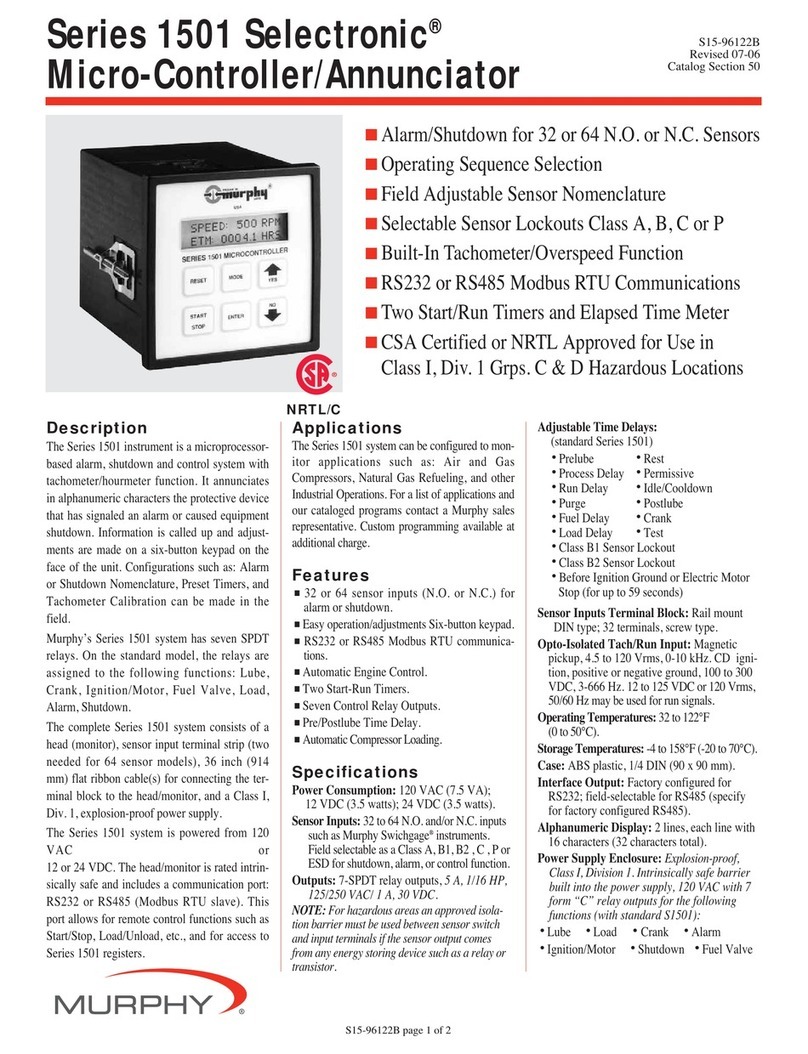
Murphy
Murphy Selectronic Micro-Controller/Annunciator Series... Specifications
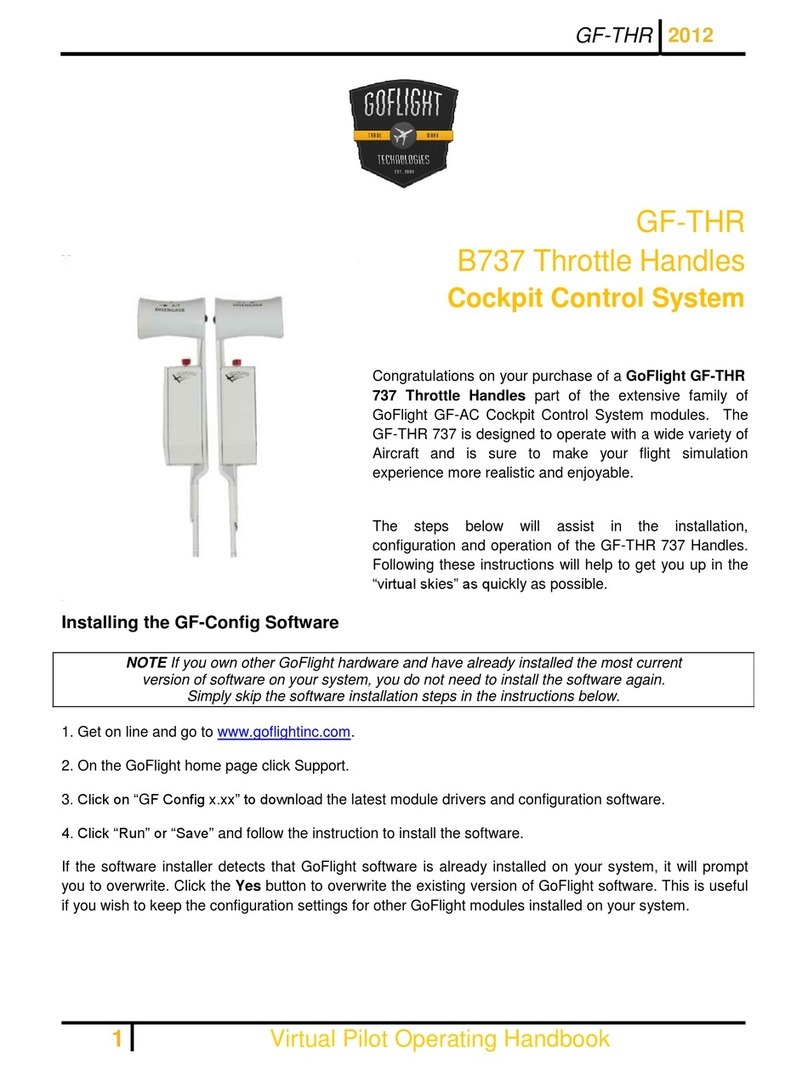
GoFlight
GoFlight GF-THR Operating handbook

PR
PR CASA ROLLO Mounting instructions
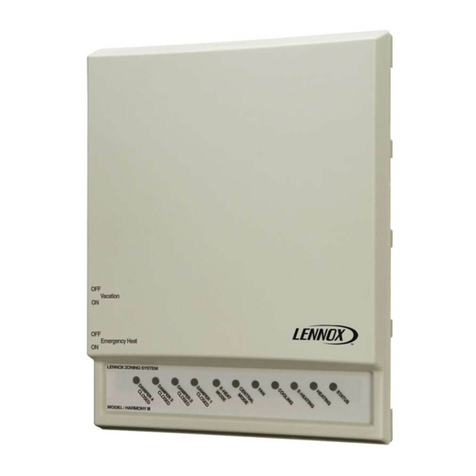
Lennox
Lennox Harmony III INSTALLATION, SETUP AND USER GUIDE
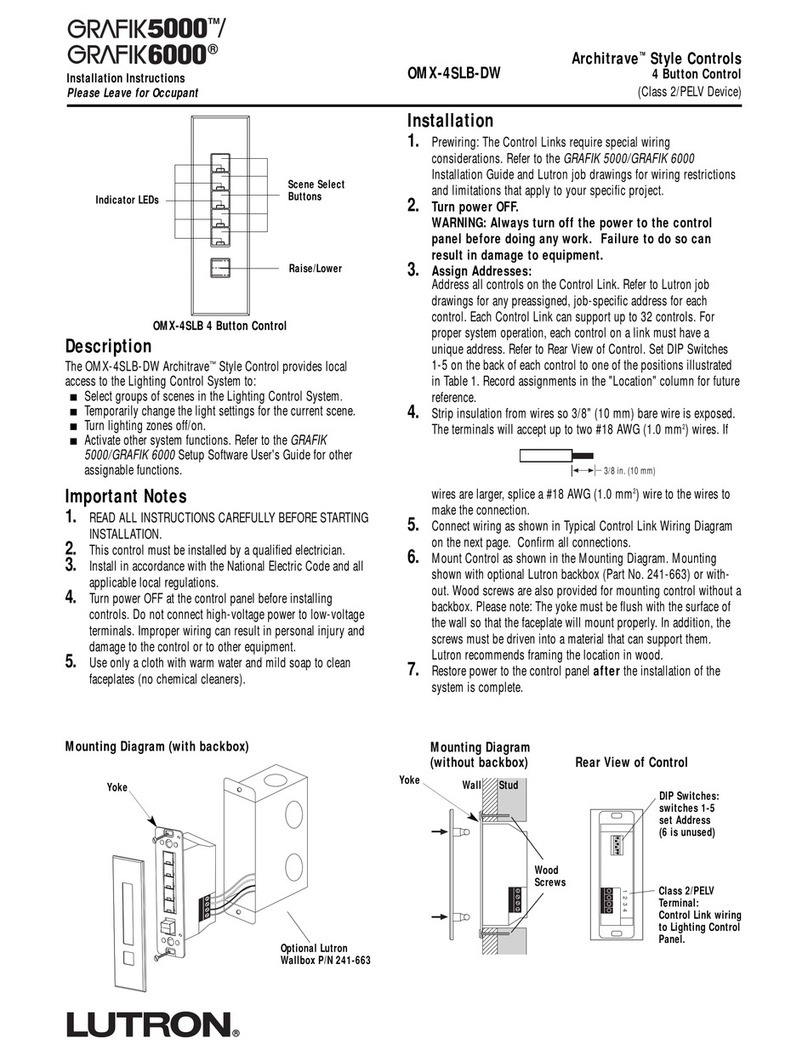
Lutron Electronics
Lutron Electronics Architrave GRAFIK5000 installation instructions

Zipato
Zipato ZIPATILE quick start guide
